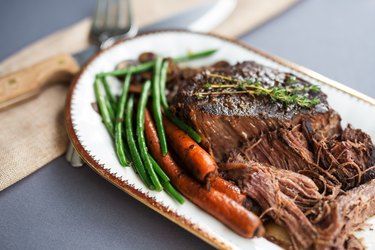
Beef bottom round roast (also sold as rump roast) is a tasty and economical cut that comes from the rear leg of the animal. Since that area gets a lot of exercise, the meat contains a large amount of connective tissue, which can make the cut tough if it is not cooked correctly. Like the similar (but fattier) chuck roast from the front shoulder, the key to getting a bottom roast that is tender and succulent — rather than dried-out and tough — is to cook it at a low temperature for a long time in a moist environment. Enter the crock-pot!
Preparing Bottom Round Roast for the Crock-Pot
Video of the Day
Since crock-pot roast beef makes great leftovers and the long cooking time is not greatly affected by the size of the roast, you can comfortably use enough meat to fill up one-half to two-thirds of your crock-pot. A larger roast can be cut into smaller pieces to fit better, and while you're cutting the pieces, you'll want to trim off any large areas of exterior fat. Most standard crock-pots can easily handle 4 to 5 pounds of raw meat.
Video of the Day
Pot roast seasoning is key to a flavorful result. While you can turn out an acceptable roast with a minimum of preparation, you'll do better by spending a little time enhancing the flavor. Salting the meat will bring moisture from the interior to the surface. The salt will mix with the meat's juices and then be reabsorbed into the roast, seasoning it deep inside.
If possible, trim your roast and cut it to size the day before you plan to cook it. Evenly sprinkle the exterior of the meat with salt on all sides. Use about a teaspoon of kosher salt or 3/4 teaspoon of finer table salt for each pound of uncooked meat. Try to season the meat a minimum of 6 hours, and, if possible, up to 24 hours, before cooking. After salting the meat, wrap it up and place in the refrigerator.
Cooking the Roast
You'll get the best beefy flavor if you take a few minutes to brown the outside of the roast before it goes in the crock-pot. Heat a couple of tablespoons of oil in a skillet for a few minutes; then place the meat in the skillet and cook it for 3‒4 minutes on each side to form a brown crust. You will hardly be cooking the meat at all, but that brown crust on the outside will translate to great taste when you're finished.
While many bottom round roast slow cooker recipes tell you to add a lot of broth, soup or other liquid, that's not really necessary. In the first few hours in the pot, the meat will slowly release much of its internal moisture, and the interior of the crock-pot will stay moist. Simply cutting up a couple of small onions to line the bottom of your crock-pot means their moisture, along with that from the roast, will provide plenty of flavor.
Place the browned pieces of meat on top of the onions you prepared, set the crock-pot to "low" and plan to leave it for at least 6 hours. If you can arrange it, a minimum of 8 hours is even better. For the connective tissue in the roast to dissolve fully, it needs to reach and then stay just under 200 degrees Fahrenheit for several hours.
As tempting as it may be to do so, avoid lifting the crock-pot's lid to see how things are going. You will lose about a half-hour of cooking time every time you do so. Patience is the key!
Once the roast has come up to temperature in the crock-pot, the tough connective tissue in the meat will slowly dissolve into gelatin and seep into the areas where the moisture has been driven away, leaving the meat with a wonderful silky texture.
A Short Rest, Then Dinner Is Served
After 6 or 7 hours at low heat, you can test the roast by piercing the surface with a knife or fork. A properly cooked roast will offer little-to-no resistance, and the blade will slide right in (if you have to push; the roast needs more time). Remove the roast to a platter, cover it with foil, and let it rest for at least a half-hour before slicing and serving.
Pour the leftover juices in the pot through a strainer into a cup and place it in the fridge. A layer of fat will rise to the top and can be spooned off; the juices below it will taste great sprinkled over the roast before serving. Serve over noodles or rice or with mashed potatoes and vegetables on the side. You'll have a great dinner tonight and plenty of juicy meat left for sandwiches tomorrow.